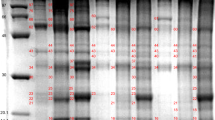Abstract
Processed mustard seed contains a considerably higher content of reducing sugar than other oilseeds. During processing, the natural reducing sugar is supplmented with glucose released by enzyme hydrolysis of the thioglucoside, and this total content reaches a value of more than 3% of the defatted mustard meal. This quantity of reducing sugar in mustard seed is three times more than that in soybean meal. Consequently, the browning reaction, which degrades protein, presents a greater problem in processing oilseeds containing thioglucosides than oilseeds free of thioglucosides. In developing the processing of mustard seed, the degree of heat treatment given the protein meals had to be determined. Several indirect methods were developed for following the effects of heat treatment on protein quality. Nitrogen solubility index, optical density of aqueous extracts, and reducing sugar content correlated well with degradation of heat-labile amino acids, such as lysine, arginine, and histidine, and gave an index of protein quality.
Similar content being viewed by others
References
Altschul, A. M., “Processed Plant Protein Foodstuffs,” Academic Press, Inc., New York, 1958, Chapt. 5.
Bensabot, L., and V. L. Frampton, J. Agr. Food Chem.6, 778 (1958).
Ettlinger, M. G., and A. J. Lundeen, J. Am. Chem. Soc.78, 4172–73 (1956).
Hannan, R. S., and C. H. Lea, Biochim. Biophys. Acta9, 293–305 (1952).
Hodge, J. E., J. Agr. Food Chem.1, 928–943 (1953).
Maillard, L. C., Compt. Rend.154, 66–68 (1912).
Markley, S. K., and A. E. Bailey, “Soybeans and Soybean Products,” Vol. I, Interscience Publishers, Inc., New York, 1950, p. 150.
Munson, L. S., and P. H. Walker, “A.O.A.C. Official Methods of Analysis,” 8th ed., Association of Official Agricultural Chemists, Washington D. C., 1955, p. 545.
Mustakas, G. C., E. A. Gastrock, E. L. D'Aquin, E. L. Griffin, Jr. and E. L. Patton, “Pilot-Plant Application of Filtration Extraction of Mustard Seed,” Abstract of Papers17A, 141st Meeting, ACS, Washington, D. C., March 20–29, 1962.
Mustakas, G. C., L. D. Kirk and E. L. Griffin, Jr., JAOCS39, 372–377 (1962).
Mustakas, G. C., L. D. Kirk and E. L. Griffin, Jr., “Mustard Seed Processing: Improved Methods for Isolating the Pungent Factor and Controlling Protein Quality,” Abstract of Papers97, 36th Meeting, AOCS, Toronto, Canada, October 1–3, 1962.
Patton, S., J. Dairy Sci.38, 457–473 (1955).
Smith, A. K., and S. J. Circle, Ind. Eng. Chem.30, 1414–1418 (1938).
Spackman, D. H., W. H. Stein and S. Moore, Anal. Chem.30, 1190–1205 (1958).
Author information
Authors and Affiliations
Additional information
A laboratory of No. Utiliz. Res. and Dev. Div., ARS, USDA.
About this article
Cite this article
McGhee, J.E., Kirk, L.D. & Mustakas, G.C. Mustard seed processing: Simple methods for following heat damage to protein meals. J Am Oil Chem Soc 41, 359–362 (1964). https://doi.org/10.1007/BF02654814
Received:
Accepted:
Issue Date:
DOI: https://doi.org/10.1007/BF02654814




